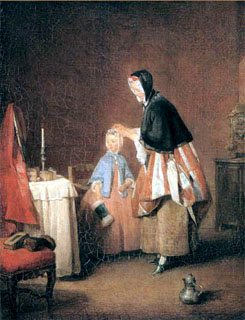After the airborne follies of the rococo; after the acres of shot silk and the teasing glances of a thousand sportive mythological nudes; after the busy, enchanting, frivolous, sensual art of Boucher and his ilk - after all that, the work of Jean-Baptiste-Simeon Chardin, painter of honest and unassuming still life and genre scenes, was a sight for sore eyes.So at least it seemed to Denis Diderot, philosophe, encyclopaedist and art critic, as he wandered through the rooms of the Paris Salon – the annual exhibition of paintings by members of the French Academy – in the year 1767:
“Looking at the pictures of others, it seems to me that I have to create artificial eyes for myself, but in order to see those of Chardin I need only keep the eyes which nature has given me, and to make good use of them… We stop before a Chardin instinctively, just as the voyager, thoroughly tired out from his travels, will choose to sit, without even realising it, in an area which proffers him verdure, silence, running water, shade and a cool, refreshing breeze.”
Never mind that Chardin never painted a landscape; his depictions of hushed bourgeois Parisian kitchens, dining- and drawing-rooms still seemed so “natural” to Diderot (he had no higher word of praise) that they amounted to a kind of second nature. In an age dedicated to high artifice and in love with dazzling virtuosity, no wonder Chardin’s superbly unaffected pictures of the world indoors came across as a breath of fresh air.
Although Chardin has often been admired for his painstaking realism (his patrons complained endlessly about the length of time it took him to finish his pictures) it is perhaps the force of his idealism that has made his art so lastingly popular and...


